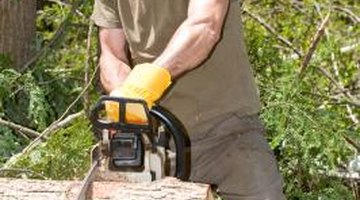What Is a Narrow Kerf Chainsaw Chain?
When you live in the country or any other rural or rustic setting, one tool you cannot do without is a chainsaw. Besides using it to cut wood for your fireplace, you need a chainsaw to cut away brush or cut up limbs that fall to the ground during summer or winter storms. Chainsaws with narrow kerfs are usually those that have light duty and are rarely used in a country setting, as the difference between a standard chain and a narrow kerf chain consists of width and application.
Kerf

The kerf is the channel left or created by the chain as it cuts through the wood. The chainsaw bar and chain determine this width. Chainsaws with narrow kerfs are light-duty or electrically powered chainsaws with thin bars and chains used for nothing more than trimming bushes or light landscaping. A narrow kerf chain would not stand up to the rigors of cutting an oak tree, which is hard on chains.
Chain Types
Chainsaws take different types of chains for use in various applications. You find professional chains on most serious woodcutters' chainsaws. These chains have a longer durability, cut faster and are available for use with a variety of bar widths. Ripping chains are used to cut parallel to the grain of wood. Sometimes people use these chains when they use a chainsaw in a sawmill attachment to create handmade boards from felled trees.
Making Chains Last
Chainsaw chains can be used repeatedly if sharpened from time to time, whenever they begin to go dull. With a special metal file, sharpen the individual teeth on the chainsaw by hand, running the file across each chainsaw tooth at a specific angle. The tooth on the chainsaw chain determines the angle of the filing or sharpening.
Practice Safety
Regardless of whether you have a light-duty chainsaw with a narrow kerf for light-brush trimming, or use a 20-inch chainsaw to fell a tree, it is important to practice chainsaw safety at all times. Each year, about 36,000 people are treated for chainsaw injuries, the Centers for Disease Control and Prevention reports, adding that most of these injuries could be prevented with better safety practices. Always choose a chainsaw and chain that are appropriate for the job. Ensure the chainsaw is in good working order and well maintained. Keep focused on the job at hand, and where goggles, heavy work gloves and other personal safety gear.
Writer Bio
As a native Californian, artist, journalist and published author, Laurie Brenner began writing professionally in 1975. She has written for newspapers, magazines, online publications and sites. Brenner graduated from San Diego's Coleman College.
Photo Credits
- Photos.com/Photos.com/Getty Images
More Articles



